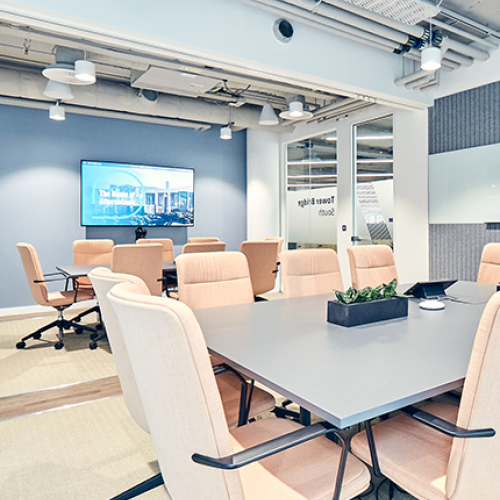Reimagine how technology plays a role in the workplace experience
In today’s hybrid world, technology bridges the gap between the physical and digital spheres. The office of...
Sameeha Joshi rounds up November's WORKTECH23 conference with her biggest takeaways.


Images courtesy of WORKTECH Events (Unwired Ventures Ltd)
In November, we headed to WORKTECH23 London, hosted at Convene, nestled inside 22 Bishopsgate. Embracing two days of insights, we explored some of the ideas that are shaping the world of work today.
WORKTECH is a holistic research and events company that aims to create awareness, drive change and provide specialist insight into the future of work and workplace. Across the globe, WORKTECH’s conferences bring together up-to-date knowledge and opinion on all aspects of work, innovation, urban realm, technology and workplace. Attended by workplace professionals from a range of global brands like Google, to PwC to the NHS, it’s a coming together of leading thinkers, industry strategists and radical visionaries.
Read on to hear about some of our key takeaways from this year’s event.
Across both days, there was a quiet but resolute confidence in the role that London continues to play across the world when it comes to work and life. Speaking from London & Partners, CEO Laura Citron outlined that while office vacancies in the UK capital are middling compared to other city centres such as Paris, Berlin, Manhattan and Hong Kong, investment in London real estate continues to top that across Europe.
However, with this knowledge comes the need to avoid complacency. Most visitors to London cited a lack of accessible Wi-Fi around the city as a major frustration. How does this translate inside our workplaces? Connectivity is increasingly important, especially considering the opportunity it affords to those working in remote settings, and it’s important to harness this as curators of workplace experience.
Hearing from Adrienne Lau of Heatherwick Studio, the call to action was clear: it’s time to humanise our cities. In 2023, 80% of the UK lives in an urban area, yet Heatherwick Studio argues that we don’t always view the development of buildings through a human lens. Modernism brings progress, but also sometimes, more insular design solutions that often neglect the living, organic role that our cities play in society.
So, how do we humanise our cities? Focus on the end-user, and all else will follow. Consider what people need from a space, and how design can attest to that. Equally, consider the role that the built environment plays in the wider ecosystem of our urban landscape. Talking through the development of Google’s offices in the Silicon Valley and King’s Cross respectively, Heatherwick Studio changed the approach when developing the latter from the former. Initially, Google’s campus in California offered ‘Googlers’ everything they could need throughout the working day.
What emerged was an insular ecosystem, and a community that didn’t contribute to the economy outside of the walls of work. For Google’s King’s Cross workplace, Heatherwick Studio has considered much more carefully how individuals can be encouraged outdoors in order to permeate and contribute to their wider surroundings, and in turn, has explored how the community can enter into the Google’s shared spaces.
What will the world start to look like in 2024 and beyond? Daniel Hulme, Chief AI Officer at WPP argues that AI can unlock the creative capacity of the workforce. By automating and making process more efficient, we’re freeing humans up to foster creativity. However, the ethics of AI use should be carefully scrutinised, and quickly. The key difference between AI and humans is that AI lacks intent, whereas intention underpins every human decision. Therefore, as humans develop AI further, bias is inevitable, and can’t be avoided. Hulme argues this isn’t a problem though, provided that intent is closely scrutinised. Additionally, the use of a range of AI tools can help to manage the risk of bias.
Long life, loose fit, is what Simon Allford of Allford Hall Monaghan Morris believes is needed when it comes to ensuring that buildings move towards a low carbon future. This means we need to design buildings to stand the test of time, that can evolve alongside our society. Discussing the global and environmental challenges we face, it’s clear that the whole building lifecycle needs to be carefully considered when designing a carbon efficient building for the future. According to the World Green Building Council, buildings are currently responsible for 39% of global energy related carbon emissions. In a typical office building, regulated and unregulated operational emissions account for 33% of the building’s whole life carbon output. Regulated emissions refers to the output from controlled building services like ventilation and lighting while unregulated emissions include output from systems operating within the space such as IT equipment and refrigeration systems.
Similarly, embodied emissions over the building’s lifecycle account for 32% while embodied emissions to the point of completion account for 35% of a building’s lifelong missions. Embodied carbon refers to the greenhouse gas emissions associated with the non-operational phase of a building’s lifecycle. That's to say the emissions released through extraction, manufacturing, transportation and then deconstruction and disposal of a building, from cradle to grave.
Therefore, responsibility and accountability sit across parties, from development to maintenance to ongoing adaptation and refit of buildings, and everyone has a part to play. The solution lies in prioritising flexibility across the built environment. Design to stand the test of time, and focus on creating a delightful experience for the end-user. Delight doesn’t mean novelty or newness, either, but focuses on the instinctive elements that bring joy, from natural light to ease of movement through a space - arguably, that’s the key to long life and loose fit.
It’s a stark realisation to hear that 80% of the people who buy lights for the places where we spend 90% of our lives have had no training in the effects of light on our lives. Typically, lighting decisions are driven by price, over and above the benefits that lighting can bring to our health, wellbeing and enjoyment of a space. Dr Shelley James is an international expert on light and its impact on wellbeing. Indeed, she likens the importance of light in supporting our health to that of air and water. On a mission to inspire others to harness the power of the lightbulb, Dr Shelley James shared how light helps our body to heal, learn and regulate our sleep patterns.
Lighting in the workplace has a profound impact on our experience within the space. In fact, people who appraise their lighting as ‘good’ will also appraise the room as more attractive, be in a more pleasant mood, be more satisfied with their work environment and as a result, more engaged in their work. As workplace experts, there’s a huge opportunity to leverage light in the environments we create to enhance the collective experience of the people that use them.
Any type of transformation represents significant change. In the professional world, this could include the adoption of new technology, a workplace relocation or a business restructure. Led by Valeria Winkworth of EY, the session explored the collaboration with Oxford Business School and EY, who conducted research into the human factors that drive transformation success and failure. A recipe for success lies in the people and the story we tell through change.
Both leaders and employees of transforming organisations undergo emotional journeys. The outcomes of these emotional journeys take different turns, depending on the successes or limitations of the transformation. The study identified six key drivers, which, when combined, helped businesses and individuals prepare for and manage the emotional journeys associated with transformation, which helped to deliver positive change. This included the need to lead, inspire, care, empower, build and collaborate to shift towards new ways of working.
Interestingly, the overwhelming thread that united the majority of the discussions at WORKTECH23 was the focus on the human, on an individual and collective level. From the buildings that we create, to the way we interact with them and the technology that exists within, it all comes back to a need to put the human experience first. So, what can we take away as designers of a working experience? Embrace technology in a way that complements humanity, shape the built environment to enable humans to thrive within it and move towards change programmes that prioritise our emotional response, ahead of project timelines and KPIs, in order to realise true potential.

In today’s hybrid world, technology bridges the gap between the physical and digital spheres. The office of...

Discover the profound impact of communication in driving transformative change. Georgia Marsh, Marketing &...

Here's how the Five Work Modes - Focus, Collaborate, Learn, Socialise and Rest - can help you to understand...

Here's how a learning culture in the workplace can enhance overall performance and wellbeing.

Your workplace holds enormous potential to improve your business performance. Get in touch today, and we will unlock that potential together.